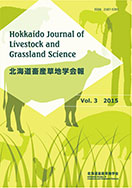The current study was undertaken to evaluate the effect of a non-forage fiber source (NFFS) on milk production, chewing activity, and ruminal mat characteristics of lactating cows. Four rumen-cannulated, lactating Holstein cows were assigned to the conventional diet of a commercial dairy farm in Hokkaido, as the control diet (CON), and a diet that substituted domestic by-products for the entire quantity of concentrate and a portion of the forage, as the experimental diet (EXP). The ratio of forage to concentrate in the CON diet and that of forage to by-products in the EXP diet was 60.4:38.9 and 53.3:45.4, respectively, based on the measurement of dry matter (DM). Cows fed EXP had increased NDF intake compared to those fed CON. Eating time and rumination time per NDF intake tended to be shorter for EXP than for CON. Total chewing time per DM intake and NDF intake were shorter for EXP than those for CON. Milk production and composition were not affected by the treatment, although milk urea nitrogen tended to be lower when cows were fed EXP. The ruminal mat consistency tended to be lower for EXP at 2 h after feeding; however, no significant effect was observed on other physical characteristics of ruminal mat at other sampling times.The proportion of small ruminal particles (< 1.18mm) tended to be higher for EXP. Ruminal fermentation parameters were not affected by the treatment, except for the concentration of ruminal NH3-N, which was lower for EXP than that for CON. Thus, normal ruminal function and milk production was maintained when the supply of NFFS was increased, even if the forage feeding ratio was low, because the ruminal mat was stratified and the rumination time was not reduced.
View full abstract
